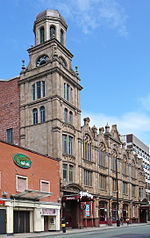Intercontinental Tower, Manchester

The Intercontinental Tower, Manchester is a cancelled landmark skyscraper that was proposed in Manchester city centre, England. The building would have been a five-star luxury hotel run by InterContinental Hotels Group, and developed by Northern Irish development firm, Benmore. The skyscraper was proposed in a press release by developer Benmore in May 2009 and discussed with Manchester City Council in summer 2009. In 2010, the tower was part of the city council's preliminary plans to regenerate the surrounding civic quarter, and opposition to building a skyscraper in the heart of its historic district had been minimal.The tower would have featured a helipad and two decorative spires, much like the Willis Tower in Chicago, which would have taken its pinnacle height to approximately 200 m (660 ft), 30 m taller than Greater Manchester's tallest skyscraper at the time, the Beetham Tower. The plans for the 48-storey tower were drawn up before the Great Recession but were abandoned when the financial market crashed. Planning negotiations resumed and architect Roger Stephenson designed a 25-storey tower to contain 270 hotel rooms and a presidential suite at the top. The theatre façade was to be retained to become the entrance to the hotel foyer. The structure was intended to be created behind the theatre's façade.
Excerpt from the Wikipedia article Intercontinental Tower, Manchester (License: CC BY-SA 3.0, Authors, Images).Intercontinental Tower, Manchester
Southmill Street, Manchester City Centre
Geographical coordinates (GPS) Address Nearby Places Show on map
Geographical coordinates (GPS)
| Latitude | Longitude |
|---|---|
| N 53.4774 ° | E -2.2466 ° |
Address
Theatre Royal
Southmill Street
M2 5GB Manchester, City Centre
England, United Kingdom
Open on Google Maps










